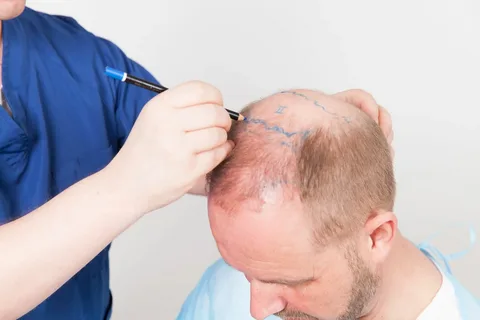Hair loss can significantly impact one’s self-esteem and overall appearance, leading many to seek out long-term solutions. One of the most effective treatments for hair loss is a hair transplant. For those considering this procedure, understanding what to expect can ease anxiety and ensure better preparedness. Whether you’re considering getting this done by a hair transplant surgeon in Indore or elsewhere, this step-by-step guide will help you understand the process and what to expect before, during, and after the procedure.
1. Initial Consultation
The first step in the hair transplant journey is the initial consultation with a qualified hair transplant surgeon. During this session, the surgeon will evaluate your hair loss pattern, discuss your medical history, and understand your goals for the procedure. The surgeon will also assess the quality of your donor hair, typically located at the back of your head, which will be used for the transplant.
1.1 Discussion of Techniques
During the consultation, your surgeon will explain the different hair transplant techniques, primarily Follicular Unit Extraction (FUE) and Follicular Unit Transplantation (FUT). The method chosen will depend on several factors, including the extent of hair loss, the condition of the donor area, and your personal preferences.
1.2 Setting Realistic Expectations
The surgeon will set realistic expectations about the outcome of the hair transplant. It’s crucial to understand that results vary depending on individual factors, and it might take several months to see the full effect. The consultation is also an opportunity to ask any questions or express concerns you may have about the procedure.
2. Pre-Operative Preparation
Once you’ve decided to proceed with the hair transplant, the next step is the pre-operative preparation. This phase involves specific instructions to ensure your body is ready for the procedure.
2.1 Medical Evaluation and Blood Tests
Your surgeon may require you to undergo a medical evaluation and blood tests to ensure you’re in good health and fit for surgery. This is to prevent any complications during or after the procedure.
2.2 Medication and Lifestyle Adjustments
You might be advised to stop taking certain medications, such as blood thinners, that could increase bleeding during the surgery. The surgeon may also recommend lifestyle adjustments, such as quitting smoking and avoiding alcohol, to promote better healing post-surgery.
2.3 Hair Washing and Care
The night before the surgery, you’ll be instructed to wash your hair thoroughly with a special shampoo provided by the clinic. This helps to reduce the risk of infection during the procedure.
3. The Day of the Surgery
On the day of the surgery, you’ll arrive at the clinic, where the hair transplant surgeon and medical team will be ready to begin the procedure.
3.1 Anesthesia Administration
To ensure your comfort during the surgery, local anesthesia is administered to numb the scalp. This means you’ll be awake throughout the procedure, but you won’t feel any pain.
3.2 Donor Hair Extraction
Depending on the technique chosen (FUE or FUT), the process of donor hair extraction will differ:
- FUE: In this method, individual hair follicles are extracted directly from the donor area using a micro-punch tool. This technique is minimally invasive and leaves tiny, barely noticeable scars.
- FUT: This method involves removing a strip of skin from the donor area, from which individual hair follicles are then dissected under a microscope. The donor area is then closed with sutures, leaving a linear scar.
3.3 Preparing the Recipient Area
Once the donor hair is extracted, the surgeon will prepare the recipient area where the hair will be transplanted. Tiny incisions are made in the balding or thinning areas of the scalp. The angle, depth, and direction of these incisions are critical for achieving a natural-looking result.
3.4 Graft Placement
The extracted hair follicles are then carefully placed into the incisions made in the recipient area. This step requires precision and artistry to ensure that the transplanted hair blends seamlessly with the surrounding natural hair.
3.5 Duration of the Surgery
The entire hair transplant procedure can take several hours, depending on the number of grafts being transplanted. For larger areas, the surgery might be done in multiple sessions.
4. Post-Operative Care
After the surgery is complete, you’ll be given detailed instructions on how to care for your scalp to promote healing and ensure the best possible results.
4.1 Immediate Post-Surgery Care
You’ll likely experience some swelling, redness, and discomfort in both the donor and recipient areas. Your surgeon may prescribe pain medication, antibiotics, and anti-inflammatory drugs to manage these symptoms and prevent infection.
4.2 Bandages and Headwear
Your scalp will be bandaged, and you’ll be advised to wear a loose hat or headband to protect the treated areas. These bandages are usually removed a day or two after the surgery during a follow-up visit.
4.3 Washing Your Hair
You’ll receive instructions on when and how to wash your hair post-surgery. It’s crucial to follow these guidelines to avoid dislodging the grafts. Typically, you’ll start with gentle rinsing, and by the end of the first week, you can wash your hair more normally.
5. Recovery and Healing Process
The recovery period is essential for the success of the hair transplant. Understanding the healing timeline can help you manage expectations and avoid unnecessary worry.
5.1 Shedding of Transplanted Hair
Within the first few weeks after the surgery, it’s common for the transplanted hair to shed. This is known as “shock loss” and is a normal part of the healing process. The hair follicles remain intact, and new hair will begin to grow in the coming months.
5.2 Hair Growth Timeline
New hair growth typically starts around three to four months post-surgery. The hair will initially be fine and light but will gradually thicken and darken over time. Full results can usually be seen within 12 to 18 months.
5.3 Follow-Up Visits
Regular follow-up visits with your hair transplant surgeon are crucial during the recovery period. These visits allow the surgeon to monitor your progress, address any concerns, and ensure the transplant is healing as expected.
6. Potential Risks and Complications
While hair transplants are generally safe, it’s important to be aware of potential risks and complications. Knowing these can help you make informed decisions and take necessary precautions.
6.1 Infection and Scarring
Infection is a rare but possible complication. Ensuring that you follow the post-operative care instructions meticulously can help prevent this. Scarring is also possible, especially with the FUT method, but with proper care, it can be minimized.
6.2 Unnatural Hair Growth
In some cases, the transplanted hair may grow in an unnatural direction or pattern. This is why choosing an experienced hair transplant surgeon is critical, as the success of the transplant heavily depends on the skill and artistry of the surgeon.
6.3 Numbness and Itching
Some patients experience numbness or itching in the donor and recipient areas after surgery. These symptoms usually subside over time but should be reported to your surgeon if they persist.
7. Long-Term Results and Maintenance
Achieving the best results from your hair transplant requires patience and long-term care.
7.1 Maintaining Hair Health
Post-transplant, it’s important to maintain the health of both your transplanted and natural hair. Your surgeon may recommend certain hair care products or treatments to support hair growth and prevent further hair loss.
7.2 Consideration for Additional Sessions
In some cases, one hair transplant session may not be enough to achieve the desired density, especially in cases of extensive hair loss. Additional sessions may be needed, which your surgeon will discuss with you based on your individual case.
7.3 Lifestyle Changes
Adopting a healthy lifestyle, including a balanced diet, regular exercise, and stress management, can significantly impact the longevity of your hair transplant results. Avoiding habits like smoking and excessive alcohol consumption is also recommended.
8. Choosing the Right Hair Transplant Surgeon in Indore
Selecting the right surgeon is perhaps the most critical factor in the success of your hair transplant. For those seeking this procedure in India, particularly in Indore, there are several highly qualified surgeons with extensive experience in performing hair transplants.
8.1 Research and Referrals
When choosing a hair transplant surgeon in Indore, start by researching online reviews, testimonials, and before-and-after photos of previous patients. Referrals from friends or family who have undergone the procedure can also provide valuable insights.
8.2 Consultation and Comfort
It’s important to feel comfortable and confident with your surgeon. During the consultation, assess how well the surgeon communicates, addresses your concerns, and explains the procedure. A good surgeon will take the time to ensure you fully understand what to expect.
8.3 Assessing Experience and Expertise
Experience matters significantly in hair transplantation. Ensure that your chosen surgeon has a proven track record of successful transplants, particularly in cases similar to yours. The surgeon’s expertise in both FUE and FUT techniques can offer you more options tailored to your needs.
Conclusion
Undergoing a hair transplant is a significant decision that can positively transform your appearance and boost your self-confidence. By understanding the step-by-step process—from the initial consultation to long-term maintenance—you can approach the procedure with confidence and realistic expectations. Whether you choose a hair transplant surgeon in Indore or another location, ensuring you are well-prepared and informed will help you achieve the best possible results from your hair transplant journey.




